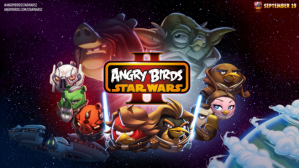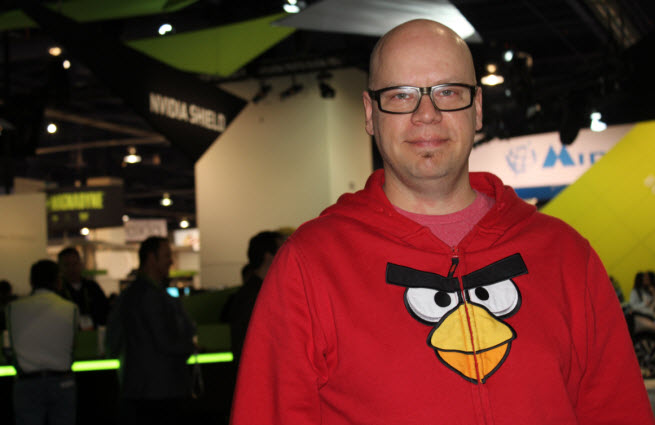GamesBeat: At the Slush event in Helsinki, I think you guys said you had more than 800 employees?
Laes: Something like that.
GamesBeat: It reminded me of how large Riot Games has become on the strength of League of Legends.
Laes: How big are they now?
GamesBeat: They have more than 1,000 people and just one game.
Laes: True. But I’m sure they have a lot of community people and the like. It’s more of a multiplayer game. That requires a big set of people in all those areas.
 GamesBeat: It’s interesting how entertainment companies can be built on just one giant hit. Then the challenge is to come up with that second one.
GamesBeat: It’s interesting how entertainment companies can be built on just one giant hit. Then the challenge is to come up with that second one.
Laes: That’s one of the reasons why Rovio decided, a couple of years ago, to break out of just building the next mobile game, and the one after that. The 52nd game or the 53rd game. Our focus on that one brand resonated so well — taking that to different places and different platforms and different forms of entertainment and different products completely, rather than purely focusing on being a games developer.
GamesBeat: Are more than half of your employees still game developers?
Laes: No, I think less than half are working on games now. But games will always be at the core of Rovio. That’s our heritage. The majority of the folks who have come from different industries to work on different areas of our business, they all experienced the game as their first encounter with the brand. When it comes to future franchises, they’ll most likely see the light of day from the games department, rather than another area of our business.
GamesBeat: What’s the reaction been like when it comes to Angry Birds moving to 3D, to a new part of gaming?
Laes: The reaction’s been very good. We were worried about the hardcore fans and what they would think about building a completely new genre, a completely new gameplay pattern. The slingshot is there at the start, but it’s a very tiny part of the gameplay. Going 3D is a very different visual style for the game. But the reception has been very good, both from critics and consumers. The game has been performing well.
There were a couple of negative voices about us going free-to-play, but it feels kind of weird, the idea that we’re not allowed to do the same thing that everyone else is doing. [laughs] We have a huge brand like Angry Birds. Of course, we want to take it easy and do it the right way, so it benefits the player and benefits us. It’s a win-win for everyone. Even if they don’t spend money, people feel like it’s the best time they’ve spent in a game, and if they do spend money, they feel like it’s the best money they’ve spent. It’s a positive experience.
 GamesBeat: Some people think the brand is shallow. How do you respond to that? How deep can you go with Angry Birds as a brand — how many places you can take it?
GamesBeat: Some people think the brand is shallow. How do you respond to that? How deep can you go with Angry Birds as a brand — how many places you can take it?
Laes: I definitely think the brand isn’t shallow at all. There’s an epic duopoly, an epic battle that’s always ensuing between the birds and the pigs. What we’ve done with Angry Birds Toons is to go deeper into the characters and the story, to shed more light on what makes them tick. Why is Chuck so obsessed with speed? Why is Red the most angry one of them? Why is Matilda the caring, motherly one? Why does Bomb explode sometimes when he’s usually so calm? Likewise the different kinds of pigs and what kind of community they have. We’ve seen tens of different types of pigs. The original flock is only about 12 characters as far as the birds. There’s a lot of depth and variety to the characters and the world we can create.
If you think about some other evergreen franchises, it’s not like they had so much going for them in the beginning either. You have a character that resonates. You have a world that makes sense and that’s interesting. Then you take it from there, peeling away the layers of the onion and telling stories that resonate with the fans and making the world a richer place.
When you have an inherent conflict and interesting characters, lovable characters, you always have a big canvas that can let you tell all kinds of stories. The conflict at the heart of it is where all those interesting narratives come from.
GamesBeat: The interactivity of technology has been an interesting theme here at CES. You guys went down the road toward this sort of digital toy with Telepods. Do you see that as an opportunity, having Angry Birds take advantage of new technology?
Laes: Definitely. With the Telepods, we’ve taken — even the first time, we had Angry Birds Magic earlier, where you could slide pigs on top of the iPad screen. We’ve toyed around with the physical-digital connection before. We’ve had codes and so on that you can register. But Telepods are the next generation of physical-digital interaction, that connection between the game and the physical world.
It’s a good start, but I think there’s so much more we can do to bridge the physical world – physical play and physical locations — with digital interactive play in a whole new way going forward. It’s even more interesting with a mobile user base than it is in the confined living room space.
GamesBeat: What’s your biggest technology hurdle or the challenge that stands in the way of your vision for where gaming is going to go?
Laes: For us, the biggest challenge is that we want to build bigger games that have higher fidelity, but represent a bigger download. On mobile networks it takes time and it’s not a convenient experience to get that download right away. We want to build games that require connectivity as you continue to play the game, to have that back end connection and cloud processing and so on available. It’s about the mobile connection, when people are on the subway or in an elevator or something like that and want to continue to have a seamless experience. Before we get to a point where the cloud is always available, always reachable with high bandwidth, that puts a limit on the kind of gaming experiences we can build on mobile. There’s enough pixels, enough power, enough fidelity to build great games on mobile, with great UI and great controls and so on. But building that long-lasting server-backed experience right now is pretty difficult on mobile.
VentureBeat's mission is to be a digital town square for technical decision-makers to gain knowledge about transformative enterprise technology and transact. Learn More










![Reblog this post [with Zemanta]](http://img.zemanta.com/reblog_e.png?x-id=e5d7635b-e3dd-47ea-9855-35bb16180c9d)
